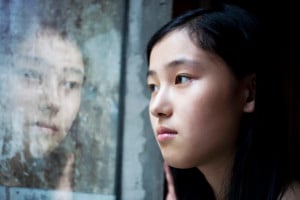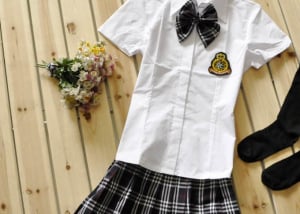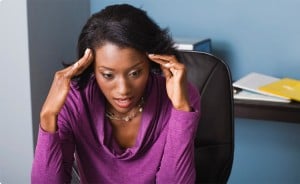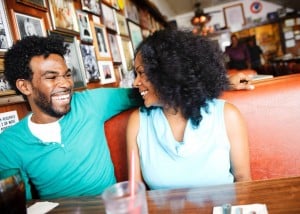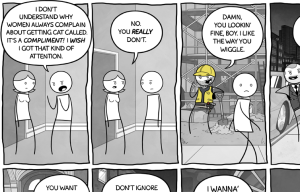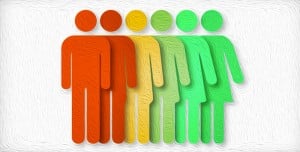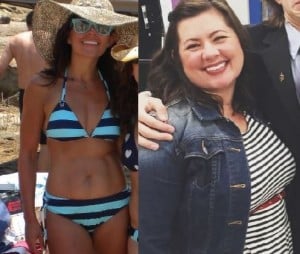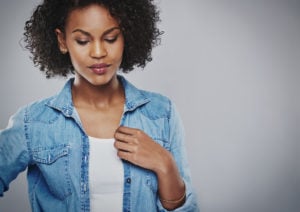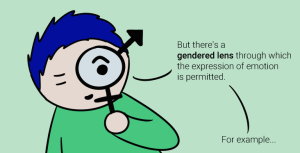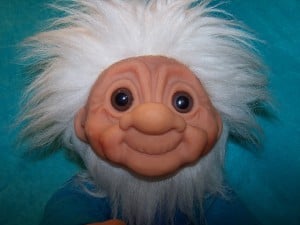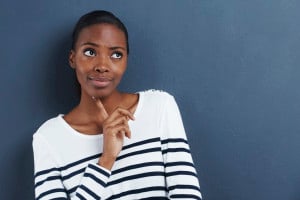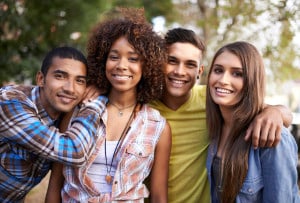
Two people embracing, one with a pride flag painted on their hand.
This article was originally published on Medium and was republished here with the author’s permission.
To me, as a queer activist and young scholar in the early 1990s, the term queer seemed to capture it all — the political urgency of combating heterosexism, my feeling and knowledge that the binaries of gender and sexual orientation were created through forced conformity and repression, the indeterminateness of my own experiences of gender and sexual attraction.
Bisexual as a term seemed too a-political, too evasive, too namby-pamby, too binary; it sounded too much like a disavowal of gayness rather than an avowal of anything. For twenty-five years or so, I’ve identified as queer — a queer person, a queer activist, a queer-theoretically informed sociologist.
During this time, I sat uncomfortably among those queers who for some reason seemed ‘realer’ to me — mostly gay men and lesbians, for whom queerness reflected their edginess and intellectual incisiveness. Looking back, as certain as I was that I was bisexual, I was afraid in some ways to be identified as bisexual.
In college, I was a charter member of the U of C Bisexual Union (UCBU, which I pronounced uck-boo), and published a letter to the editor of the student paper about bisexuality. Closeted isn’t what I’ve been.
My college sweetheart was a man and as sweet and fun as that relationship was, it was almost unbearable for me to be thought of as straight by virtue of having a “sweetie” whom others simply saw as my “boyfriend.”
When that relationship ended amicably, I determined never to have a serious relationship with a guy again. Feeling a sense of home and commonality with other queers, who mostly identified as gay or lesbian, I didn’t want to be an outsider, and I especially didn’t want to be an outsider exiled back to “straight” space.
There are straight people in my life whom I love very much — I can joke ironically that “some of my best friends are straight” — but to be straight, or to be thought to be straight, is something I still have trouble bearing. Foreclosing a real relationship with a man was for me a way of securing my place among queers, a way to belong fully.
I felt a kinship with other queer-identified bisexuals, but I often couldn’t bring myself to say with them that I was bisexual. I felt a kinship with trans people and certainly with nonbinary people, but only now can I see that I was both hiding and trapped by an invisible stigma, while they were often burdened by a more visible one — if not visible on their bodies, visible in their documents or biographies.
Something didn’t quite make me feel at home in the queer theory crowd. Even brilliant queer theorists — who I knew didn’t see gender as the most important determinant of whether someone was attractive, hook-up-worthy, or relationship material — seemed to downplay their bisexuality.
Queer theorists spoke of disrupting binaries such as male/female and hetero/homo, but the fact that bisexuals’ lived experience of gender disrupts both of those binaries never seemed to even enter the conversation.
Even Judith Butler’s 1993 Bodies That Matter, a book that was crucial in the development of queer theory, of the creation of new ways of being gendered, and of my own thinking, mentioned bisexuality only once — in a sentence expressing almost surprise that the term was being claimed by “bisexuals and straights for whom the term expresses an affiliation with anti-homophobic politics” (p. 230).
It always seemed to me that gays, lesbians, and straights all saw gender as the most important characteristic determining whether someone was attractive or not and that not being affected that way by others’ gender was pretty damned queer, maybe even more so than being gay or lesbian.
But here was a brilliant visionary of feminist and queer politics, someone who literally made trans and genderqueer identifications thinkable and possible for some people, basically defining bisexuality as pretty much straight, thinking bisexuals to be as affected by homophobia as straight people who find it disagreeable or wrong.
As “queer,” I could study queer theory, study how conformity was reproduced and enforced. I even wrote about how bisexuality was among the things ruled out of existence both by Christians who viewed homosexuality as sinful and by their liberal Christian interlocutors who insisted that same-sex relationships were okay because gay people “couldn’t help it.” I vocally and repeatedly challenged that “can’t help it”/”bad choice” language everywhere I could.
I explained what bisexuality meant to those who didn’t understand; I commented on how anti-LGBT activists, well-intentioned liberals, and radical queers all foreclosed bisexuality from the world of possibility.
But I remained more invisible than I realized under a giant queer umbrella that I thought conveyed my truth, not realizing the extent to which no one could see it.
Seeing the Invisible
In Fall 2015, I was doing fieldwork on evangelical, fundamentalist, and other conservative Christians’ growing acceptance of LGBT identities, same-sex marriage, and gender transition.
At a Christian conference, someone caused me to shift my whole paradigm. Eliel Cruz was leading a workshop on bisexuality at a conference of The Reformation Project. He spoke of bi-invisibility and bi-erasure, concepts developed by bisexuals in the 1990s, but that I had completely ignored, so busy was I making myself fit in.
Reading up on it later, I learned from an article by legal scholar Kenji Yoshino that every sex survey that has ever been done has found at least as many bisexual men and women as gays and lesbians.
Far from being a teensy and inconsequential minority, bisexuals actually make up half, or more, of the LGBT population. I actually worked on one of those studies as a graduate student, and I never knew this. Erasure and invisibility are apt terms.
As a conservative Christian, Eliel spoke of the beauty of in-betweenness, the ways that scripture itself inspired awe for the vast spectra of creation. He remarked:
We live in a world where it’s easier to deal with the black and white, one or the other, the binary. But the truth is, that’s not how God created us. We are more complex than that. God’s creation is nothing close to binary. Can you stand with your feet in the muddy sand on the beach, waves crashing around your feet, tide slowly rising or falling, and honestly draw a clear line between sea and dry land?
Drawing from their religious knowledge, LGBTQ-affirming “conservative” Christians are coming to challenge that binary in a way even the edgiest queer theorists have not.
I had thought of myself as an uncompromising, unabashed queer feminist scholar. I let myself be denied tenure rather than make my work less threatening and more innocuous. I would not be cowed by people who preferred their gay and lesbian colleagues to mind their place.
But, all of a sudden I saw how compromising, how unqueer, how afraid I had been for my whole career.
I wasn’t afraid of heteronormative straight people. I was afraid of gay men and lesbians relegating me to the realm of straight people, fancying themselves queerer than I, paradoxically because I was less invested in the gender dichotomy than they.
Cruz helped me to see ways in which my own thinking about gender and sexuality had failed to problematize binary thinking, even as I resisted binary gender.
It happened because I was invested in a queer theory that spoke of disrupting the ideological power at work in binary thought, but that failed to see how the gender binary structured its own critiques.
Trans historian Susan Stryker has written about the ways that even radical theorists relegate the scholarly insights of trans thinkers and activists to the margins, to the outside space of “public thought” as opposed to the more “serious,” “scholarly” place where the results of other research are published.
Kenji Yoshino summed up and built on a generation of bisexual authors before him who observed bi-erasure in the 1980s and 1990s. And in spite of the fact that their initial is sometimes appended on to the list of letters (as in LGBTQI) I think it’s safe to argue that insights from intersex people have not been fully incorporated into the agenda of LGBT activism or scholarship.
***
The alphabet soup acknowledges all the people who are harmed by a rigid gender binary, but queer politics is just beginning to open up to the vast ranges of human possibility.
The fact that I only recently saw this story about the health and other disparities faced by bisexuals speaks to a bigger sea change happening around us, and also made me feel like I had to share my story now.
Thank you to the vocal, out bisexuals who have refused to be made invisible for decades. Thank you to the trans and gender queer people who have been holding the so-called “LGBT community” and queers accountable for marginalizing them.
We are at a turning point in how we think about gender.
Historically, such moments of huge progressive potential have often come to a grinding halt — the seventies ended when the eighties started — but in a world where market researchers can find that 51% of teens identify as something other than straight, I’m enjoying the potential while we have it.
[do_widget id=’text-101′]
Dawne Moon is a sociology professor and author of God, Sex, and Politics: Homosexuality and Everyday Theologies. She is currently studying the movement among conservative Protestants to affirm LGBTQI identities, same-sex marriage, and alternative gender expressions. Like most bisexuals, she sees bisexuality as a non-binary orientation.
Search our 3000+ articles!
Read our articles about:
Our online racial justice training
Used by hundreds of universities, non-profits, and businesses.
Click to learn more







